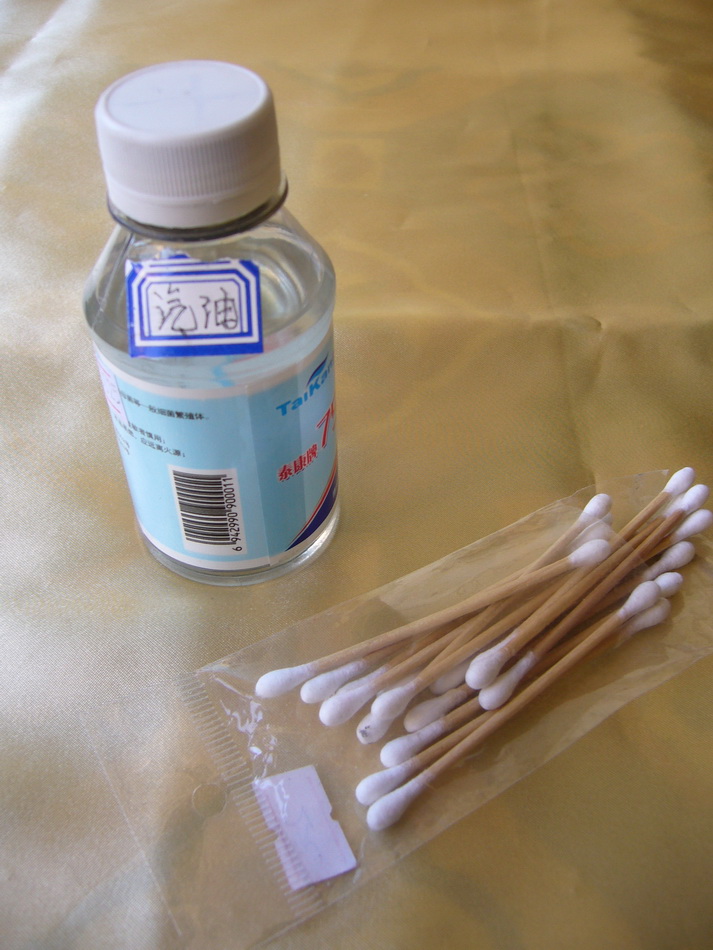Question: How should embroidery works be maintained and preserved? What are the best practices for cleaning, storing, and preserving embroidery?
Answer: Proper maintenance and storage of embroidery are crucial aspects of embroidery collection. If not properly cared for, stored embroidery can cause trouble for the collector and even lead to unnecessary financial losses. Therefore, preservation of embroidery is a topic of significant concern for collectors.
While we may not have access to the scientific instruments and equipment used by professional museums to assist in preservation, there are still effective traditional methods in the folk sector that can be used for embroidery collection. Unlike unearthed artifacts, these folk collections are generally passed down through generations, making their preservation less complicated.
Cleaning Method:
When acquiring an embroidery piece, do not immediately clean it upon bringing it home. Prepare a new goat hair brush, a new wolf hair brush, and a camera lens blower. First, gently sweep the surface of the embroidery with the goat hair brush. After sweeping, use the blower to remove surface dust. Then, carefully sweep out any larger particles or dirt hidden in the seams with the wolf hair brush, especially for older embroidery that may have residues of insects not visible to the naked eye. Finally, use the blower again to remove any dust or brush hairs left behind, ensuring a clean embroidery surface.

Cleaning tools for embroidery
Oil Stain Removal Method:
If you notice oil stains on the embroidery, do not wash it with water or use soap powder for spot cleaning. It is best to use aviation gasoline or, if possible, jet engine fuel. Using a cotton swab dipped in a small amount of gasoline, gently wipe the area with the oil stain. The stain will be easily removed. Be sure to apply light pressure during wiping to avoid leaving irreversible marks on the embroidery surface.

Degreasing tools
Gentle Washing Method:
Some embroidered garments might have been worn or used before you acquired them. To ensure their quality during storage, you can consider washing them. However, this washing process requires extreme caution to avoid damaging the embroidery. First, find a piece of gauze fabric, whether synthetic or cotton, and sew it over the embroidery surface. Place it in the washing machine with a small amount of shampoo for gentle washing, ensuring the washing time is short. Afterward, rinse it by hand in clean water, then lay it flat and press out the excess water. Once dry, use a medium-heat iron to smooth it out.
Note: Before washing, gently pull the fabric at the edges of the embroidery to check its tensile strength. If the fabric tears easily, it indicates that the fibers are weak due to age, and the piece should not be washed. Similarly, if there are multiple breaks or loose threads in the embroidery, avoid washing and maintain the original condition. Ensure that you eliminate all factors that make washing inadvisable before proceeding.

Gently wash to protect the veil

The embroidery surface is aged and should not be washed
Storing Embroidery:
When an embroidered piece is not being framed or hung, it can be temporarily stored by covering it with a layer of transparent white paper, then wrapping it in newspaper. Lay it flat in a box, cabinet, or drawer, without placing any chemical mothballs or insecticides, as the ink in the newspaper provides sufficient protection against pests. Avoid using camphor balls, as they can damage silk fabrics.

Store the embroidery covered with newspapers
Temperature and Humidity Considerations:
Embroidered pieces should be stored at room temperature and should not be moved frequently. If you must transport them to another location, choose a time when the weather conditions are similar between the two places. For instance, if moving embroidery from the north to the south, avoid the rainy, damp, or foggy seasons in the south, as these conditions can negatively affect the embroidery. Conversely, when bringing embroidery from the south to the north, select a time with similar weather, such as late autumn when the weather is cool and dry, and the temperature and humidity differences are minimal. In summary, embroidery is highly sensitive to temperature and humidity variations, and careful attention is necessary to extend the life of your collection.
Framing for Preservation:
Framing embroidery is an excellent method for preserving it while also allowing for display and environmental enhancement. A framed embroidery piece is kept in a relatively sealed, undisturbed environment, free from dust, and protected from unintentional contact during viewing. However, avoid placing the frame in direct sunlight or using adhesives inside the frame.

Avoid using glue to glue the embroidery
There are many other methods for preserving embroidery, which you can discover, accumulate, and summarize throughout your collection journey.
问:如何保养和保存刺绣作品? 刺绣如何清洁、保管与存放?
答:刺绣的保管与存放,是刺绣收藏的一个重要环节,所藏的刺绣如不能妥善保管,很可能给藏者带来烦恼,若存放失当还会带来不必要的经济损失。因此,刺绣的保存也是收藏者比较关心的话题。
那么,在刺绣的收藏过程中,虽然我们不可能像专业的博物馆藏品那样,有一些科学的仪器和器材协助保管,但民间亦有可供参考的行之有效的方法利于刺绣的收藏,而且民间的收藏,基本都是传世的,情况没有出土的那么复杂。
1、清洁法:
当收购到刺绣藏品后,拿回家后,不要马上就一下清洁处理,准备一支新的羊毫笔,一支新的狼毫笔,一个用于相机镜头保养的气吹,先用羊毫笔在刺绣的表面轻轻地扫一遍,扫过后,用气吹吹几下,吹掉表面的浮尘,然后,再用狼毫笔仔细扫出有可能比浮尘更大,或藏在线缝里的污垢、颗粒,尤其是年久的刺绣很可能会有些肉眼看不到的蛀虫之类的残垢,而后,再用气吹吹一遍,去掉用笔扫出来的浮尘和有可能从毛笔上掉落的笔毛,确保绣面的清洁(图)。
2、去油渍法
你所购的刺绣品,如发现或不小心染上了油渍,千万不要轻易下水洗涤,也不要考虑用肥皂粉去污渍之类的局部搓洗,最好选择航空汽油,有可能的话选择航空发动机汽油更好。操作时,用棉签蘸少许汽油,在有油渍的地方轻轻擦拭,油渍就会轻松去掉,注意擦拭时的动作一定要轻,不能因急于去垢而用力太过,以免在绣面上擦出无法修复的痕迹。(图)
3、轻柔水洗法
有的刺绣服饰,买回来之前很可能被人穿着、使用过,这样的绣品为确保其存放的质量,可以考虑用水洗。不过,这种水洗方式需格外小心,以免洗烂了,造成损失。先找一块纱质的布料,化纤、棉质的不拘,(图315)用缝针缝遮住绣面,放在洗衣机里,搁少许洗发液以轻柔洗涤,不要时间太长,然后取出,用手工在清水中漂清,提出水面后平放挤压干绣件中的水分,等晾干后,用熨斗中温熨平即可。
注:水洗前,要先检查一下,轻轻拉一下刺绣的边缘布料上的纤维,看看牵引度如何。如若轻轻一拉就断,说明绣品年久,纤维已很弱,不可水洗,只能保持现状。还有一种即绣品有多处绣线断开、脱落,这样的也尽量维持原状,可采用第一种方法,但不可水洗。总之,要先行排除了一些不可水洗的因素后,再动手水洗,不可草率而为。(图)
4、刺绣的存放法
清洁后的刺绣,在暂时不夹入镜框或不装裱悬挂时,可先用一层透明白纸覆盖再用报纸包好,平放在箱子、柜子或抽屉内,不要放任何的防虫丸、剂之类的化学物品,报纸的油墨即有防蛀作用。(图)而樟脑丸这类的防蛀剂对丝织品会有损害,勿用。
5、温湿度注意法
刺绣品一般应放在常温下保管,不要随便更换地方,若要携带去外地,必须选择在两地相对一致的天气下进行。比如想将绣品从北方带到南方,最好不要选在南方的雨季、霉雨天、雾天等,那样对刺绣的影响会比较大;反之,若从南方带往北方,也要选一个相对和北方较为一致的天气,如深秋季节,这时的天气都是秋高气爽,空气温度比较适中,湿度差也较小。概而言之,刺绣品最忌温度和湿度的反差,想要延长刺绣藏品的寿命,以上所述须多加留意。
6、装框保存法
将刺绣装入镜框,一方面可以随时欣赏、美化环境,一方面也是对收藏刺绣的最好保护法。让刺绣在镜框中,相对长期处于一个较密封、无干扰的小环境中,没有灰尘,也避免了观赏时不经意的手触、鼻息、口气等影响。但要注意不可将镜框挂在有阳光长时间直射的位置,更不可用胶粘在镜框里。(图)
收藏刺绣的方法其实还有不少,大家可以在收藏过程中不断寻找、积累和总结。




